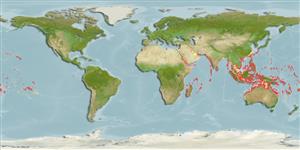分類 / Names
俗名 | 同種異名 | Catalog of Fishes(屬, 種) | ITIS | CoL | WoRMS | Cloffa
Teleostei >
Eupercaria/misc (Various families in series Eupercaria)
鱸形目 (Various families in series Eupercaria) >
Labridae (Wrasses)
隆頭魚科 (Wrasses) > Cheilininae
Etymology: Epibulus: Greek, epi = over, in front + Greek, boleo = to throw (Ref. 45335).
More on author: Pallas.
Environment: milieu / climate zone / depth range / distribution range
生態學
海洋 礁區魚類; 深度上下限 0 - 50 m (Ref. 128797). 熱帶; 30°N - 30°S
Indo-Pacific: Red Sea to South Africa (Ref. 35918) and the Hawaiian and Tuamoto islands, north to southern Japan, south to New Caledonia.
印度-太平洋: 紅海到南非 (參考文獻 35918) 與夏威夷與 Tuamoto 島, 北至日本南部, 南至新加勒多尼亞。
大小 / 重量 / 年齡
Maturity: Lm ? range ? - ? cm
Max length : 54.0 cm SL 雄魚/尚未辨別雌雄; (Ref. 9823)
背棘 (總數) : 9 - 10; 背的軟條 (總數) : 9 - 11; 臀棘: 3; 臀鰭軟條: 8 - 9. The mouth of this species is protrusible and unfolds into a tube easily half the body length. The jaws swing forward into a long tube that strong suction to catch prey. When not in use, the entire apparatus is conveniently folded under the head. Small juveniles are brown with thin white bars and closely resemble a species of Wetmorella. Color varies with age and sex, but adult color varies additional, including with an all-yellow xanthic form. Sub adults and females are brown or, not uncommonly, uniformly yellow. Terminal males are dark with a white head and a dark streak extending horizontally through the eye. Male becomes ornamented with orange and yellow over the back. Juveniles dark with fine vertical white lines. Intermediates with yellow blotches, pale tail and sometimes with black pectoral fins (Ref. 48636).
這種的嘴巴是能伸展的而且展開成管容易一半體長。 顎搖擺進入長的管之內向前哪一強的吸捕捉獵物。 當不在使用中,整個的器官方便地在頭部下面被摺疊的時候。 小的稚魚是褐色的有白色細紋而且非常近似一個 Wetmorella 的種. 顏色隨著年齡與性別改變,但是成魚顏色改變附加的, 包括有一個全黃的黃色形式。 亞成魚與雌性是褐色或, 不稀有地, 全身黃色的。 最後階段的雄魚是深色且有一個白色的頭部與一個深色條紋水平地延伸經過眼。 雄性變成裝飾有橘色的與黃色的整個背部。 稚魚深色且有細的垂直白色的線。 中間物有黃色的斑塊, 灰白的尾部而且有時有黑色的胸鰭.(參考文獻 48636)
Inhabit coral-rich areas of lagoon and seaward reefs (Ref. 1602, 58302). Benthopelagic (Ref. 58302). Generally solitary (Ref. 5213). Feed on small coral-dwelling crustaceans and fishes (Ref. 9710). Capable of drift migration along with floating leaves (Ref. 27153). Adults usually along deep slopes or drop-offs. Sometimes they visit cleaning stations holding their mouth open and out for inspection (Ref. 48636).
棲息於潟湖與臨海礁石的珊瑚豐富的區域。 (參考文獻 1602) 通常獨居性的.(參考文獻 5213) 捕食小的棲息於珊瑚的甲殼動物和魚類。 (參考文獻 9710) 能夠與漂浮樹葉一起漂浮遷移。 (參考文獻 27153) 成魚通常沿著深處的斜坡或海峭壁。 有時他們拜訪握住他們的嘴的清潔的區域開放的與出自對於檢查.(參考文獻 48636)
Life cycle and mating behavior
Maturities | 繁殖 | Spawnings | Egg(s) | Fecundities | 仔魚
Males have been observed patrolling their mating territory (see Ref. 27152). Protogyny was proposed but not confirmed (Ref. 103751).印度-太平洋: 紅海到南非 (參考文獻 35918) 與夏威夷與 Tuamoto 島, 北至日本南部, 南至新加勒多尼亞。
Randall, J.E., G.R. Allen and R.C. Steene, 1990. Fishes of the Great Barrier Reef and Coral Sea. University of Hawaii Press, Honolulu, Hawaii. 506 p. (Ref. 2334)
人類使用
漁業: 低經濟; 水族館: 商業性
工具
特別的報告
下載 XML
網路資源
Estimates based on models
Preferred temperature (Ref.
123201): 24.7 - 29, mean 27.9 °C (based on 790 cells).
Phylogenetic diversity index (Ref.
82804): PD
50 = 0.7500 [Uniqueness, from 0.5 = low to 2.0 = high].
Bayesian length-weight: a=0.02239 (0.01234 - 0.04062), b=2.95 (2.79 - 3.11), in cm total length, based on LWR estimates for this species & (Sub)family-body (Ref.
93245).
營養階層 (Ref.
69278): 4.0 ±0.66 se; based on food items.
回復力 (Ref.
120179): 低的, 最小族群倍增時間4.5 - 14 年 (Preliminary K or Fecundity.).
Fishing Vulnerability (Ref.
59153): Moderate to high vulnerability (46 of 100).
Nutrients (Ref.
124155): Calcium = 36.4 [12.3, 145.1] mg/100g; Iron = 0.515 [0.197, 1.250] mg/100g; Protein = 18.4 [15.4, 20.7] %; Omega3 = 0.133 [0.067, 0.276] g/100g; Selenium = 32.4 [11.6, 84.5] μg/100g; VitaminA = 65.8 [17.4, 310.7] μg/100g; Zinc = 1.95 [0.61, 3.51] mg/100g (wet weight); based on
nutrient studies.
